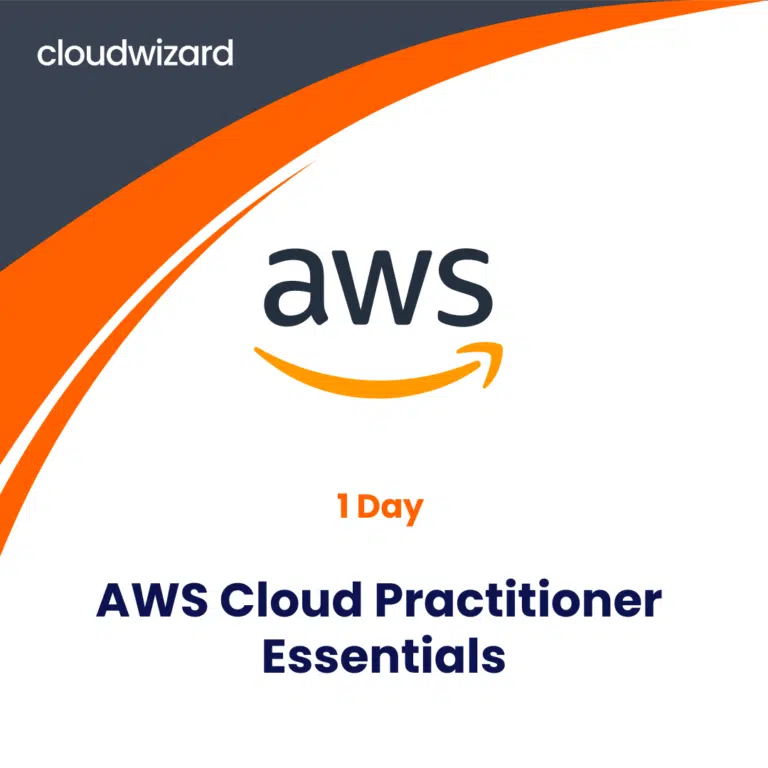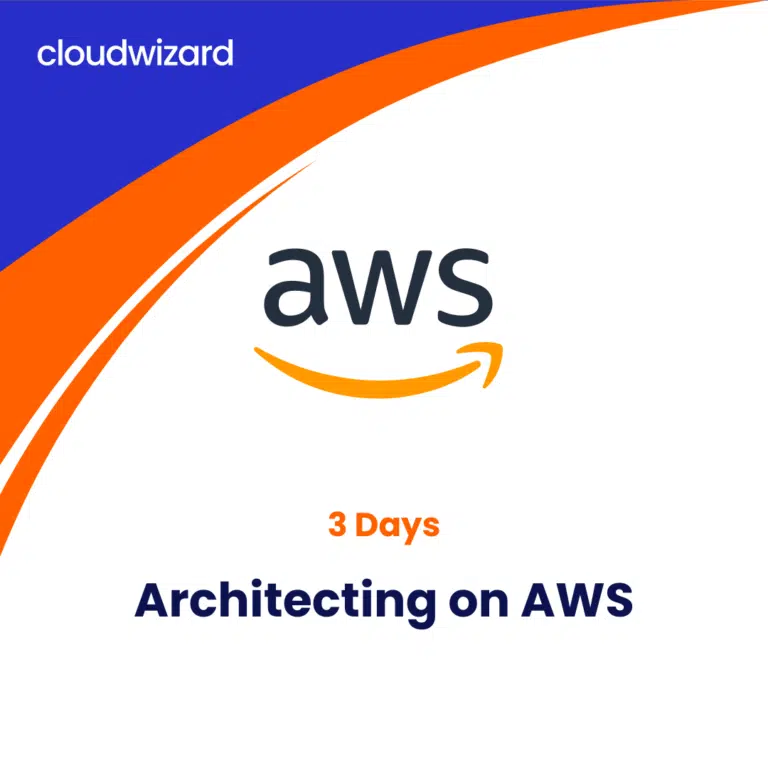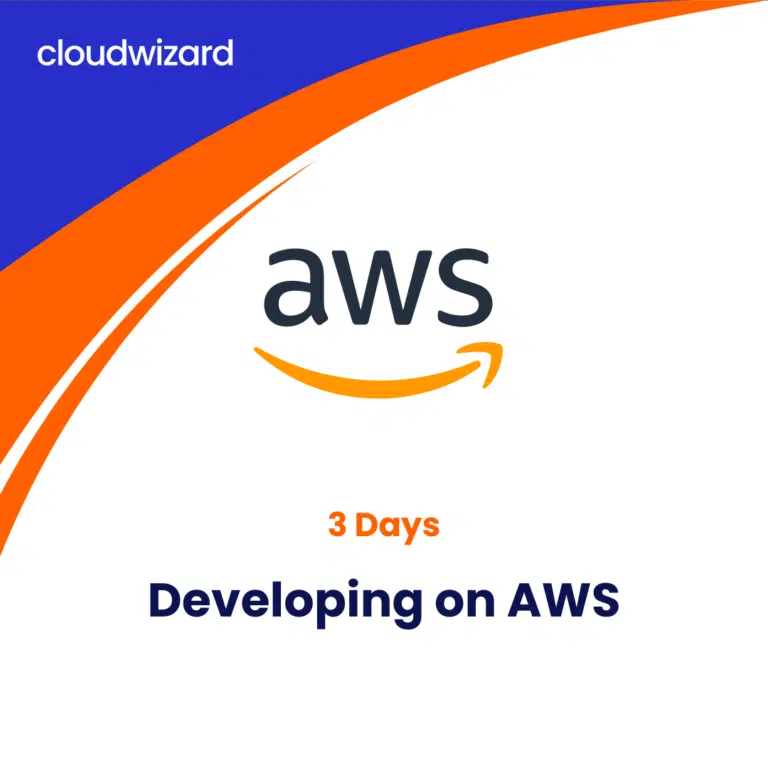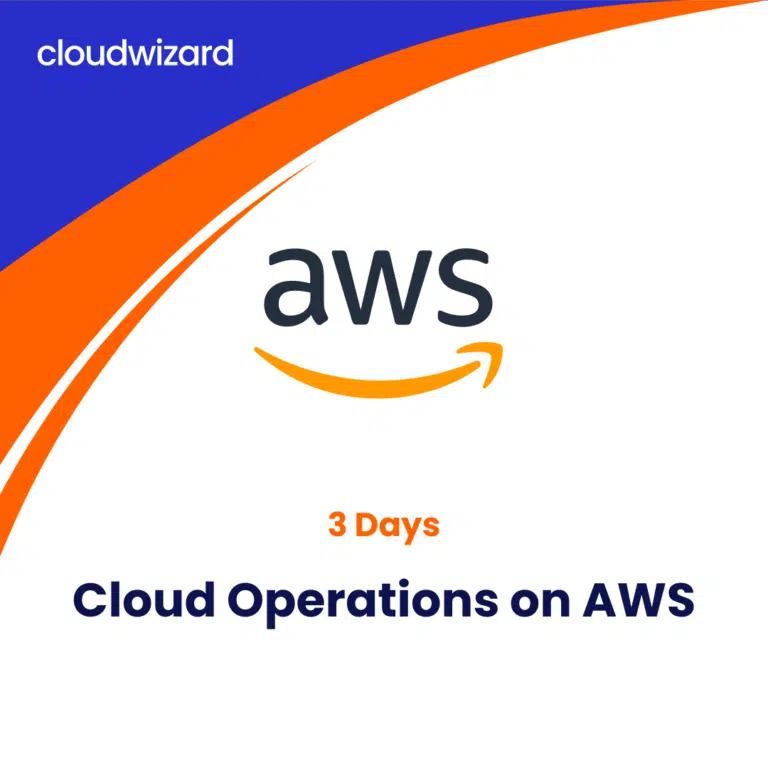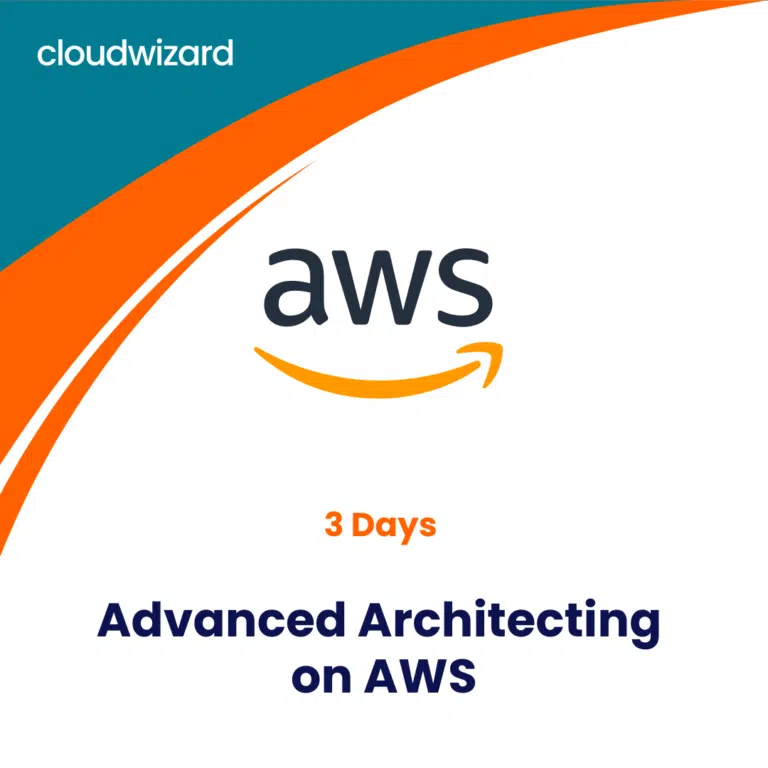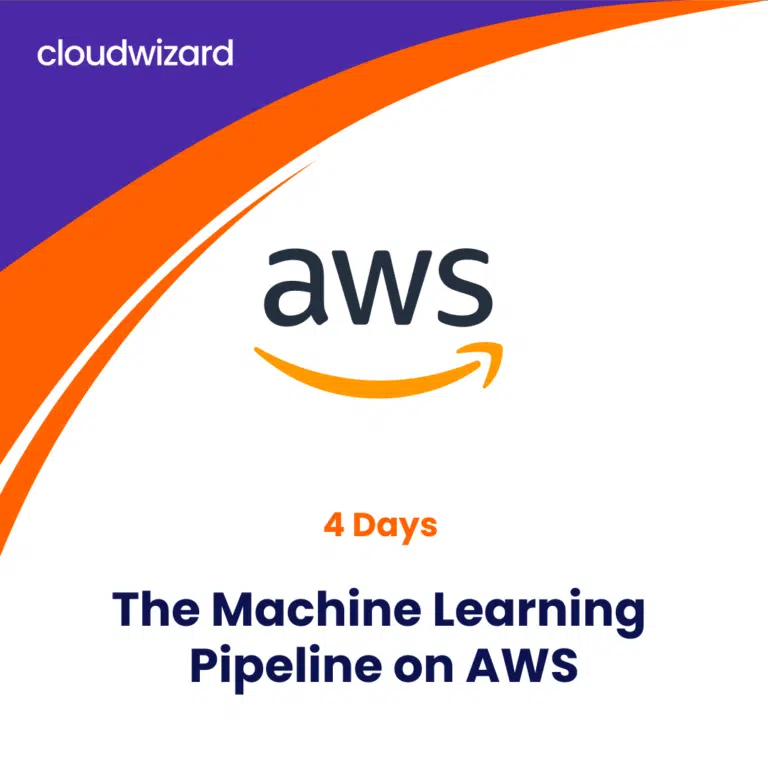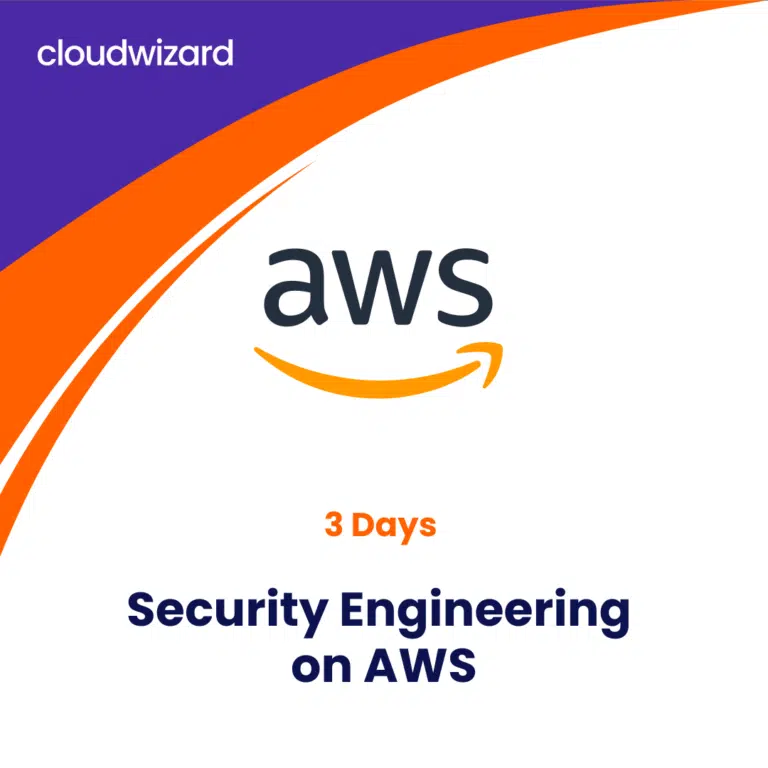AWS Cloud Practitioner Essentials
This course is designed for individuals with little to no experience on the AWS Cloud. The learners will learn about AWS Cloud concepts, AWS services such as Security, AWS Architecture, Pricing and Support to develop their knowledge on the AWS Cloud.
AWS Services such as Compute, Networking, Database and Storage along with AWS Well-Architected Framework, AWS Cloud Migration and the shared responsibility model are covered in detail. The course also helps in preparation for the AWS Certified Cloud Practitioner Exam
The course can be taken up Sales, Legal, Marketing, Business Analysts, Project Managers, IT professionals and anyone in general looking to start up within the AWS Cloud domain.The course is delivered by an Amazon Authorised Instructor with a mix of presentations, class activities and frequent knowledge checks.
1 Day / 8 Hours
Live Class
Certificate on completion
You will learn about the following
- The working definition of AWS
- Differences between on-premise, hybrid cloud & all-cloud systems.
- Describe the AWS Cloud’s fundamental global infrastructure.
- Six advantages of the AWS Cloud.
- Understand AWS services such as Compute, Network, Databases & Storage
- Explain the AWS Well-Architected Framework.
- Describe the shared responsibility paradigm | AWS Cloud’s primary security services.
- Migration to the AWS Cloud.
- Financial advantages of the AWS Cloud for cost control in a business.
- Fundamental Payment | Account management and pricing structures.
- Preparing for the AWS Certified Cloud Practitioner Exam (CLF-C01)
What experience you need
- General IT knowledge of how Computers work
Who should take this course
- Freshers looking to prepare for the AWS Certified Cloud Practitioner Exam
- Business Analysts | Legal personel
- Marketing | Project Managers
- Sales | Other IT professionals
Module 1: Introduction to Amazon Web Services
- Summarize the benefits of AWS
- Describe differences between on-demand delivery and cloud deployments
- Summarize the pay-as-you-go pricing model
Module 2: Compute in the Cloud
- Describe the benefits of Amazon Elastic Compute Cloud (Amazon EC2) at a basic level
- Identify the different Amazon EC2 instance types
- Differentiate between the various billing options for Amazon EC2
- Describe the benefits of Amazon EC2 Auto Scaling
- Summarize the benefits of Elastic Load Balancing
- Give an example of the uses for Elastic Load Balancing
- Summarize the differences between Amazon Simple Notification Service (Amazon SNS) and Amazon Simple Queue Services (Amazon SQS)
- Summarize additional AWS compute options
Module 3: Global Infrastructure and Reliability
- Summarize the benefits of the AWS Global Infrastructure
- Describe the basic concept of Availability Zones
- Describe the benefits of Amazon CloudFront and Edge locations
- Compare different methods for provisioning AWS services
Module 4: Networking
- Describe the basic concepts of networking
- Describe the difference between public and private networking resources
- Explain a virtual private gateway using a real life scenario
- Explain a virtual private network (VPN) using a real life scenario
- Describe the benefit of AWS Direct Connect
- Describe the benefit of hybrid deployments
- Describe the layers of security used in an IT strategy
- Describe which services are used to interact with the AWS global network
Module 5: Storage and Databases
- Summarize the basic concept of storage and databases
- Describe benefits of Amazon Elastic Block Store (Amazon EBS)
- Describe benefits of Amazon Simple Storage Service (Amazon S3)
- Describe the benefits of Amazon Elastic File System (Amazon EFS)
- Summarize various storage solutions
- Describe the benefits of Amazon Relational Database Service (Amazon RDS)
- Describe the benefits of Amazon DynamoDB
- Summarize various database services
Module 6: Security
- Explain the benefits of the shared responsibility model
- Describe multi-factor authentication (MFA)
- Differentiate between the AWS Identity and Access Management (IAM) security levels
- Describe security policies at a basic level
- Explain the benefits of AWS Organizations
- Summarize the benefits of compliance with AWS
- Explain primary AWS security services at a basic level
Module 7: Monitoring and Analytics
- Summarize approaches to monitoring your AWS environment
- Describe the benefits of Amazon CloudWatch
- Describe the benefits of AWS CloudTrail
- Describe the benefits of AWS Trusted Adviso
Module 8: Pricing and Support
- Understand AWS pricing and support models
- Describe the AWS Free Tier
- Describe key benefits of AWS Organizations and consolidated billing
- Explain the benefits of AWS Budgets
- Explain the benefits of AWS Cost Explorer
- Explain the primary benefits of the AWS Pricing Calculator
- Distinguish between the various AWS Support Plans
- Describe the benefits of AWS Marketplace
Module 9: Migration and Innovation
- Understand migration and innovation in the AWS Cloud
- Summarize the AWS Cloud Adoption Framework (AWS CAF)
- Summarize six key factors of a cloud migration strategy
- Describe the benefits of various AWS data migration solutions, such as AWS Snowcone, AWS Snowball, and AWS Snowmobile
- Summarize the broad scope of innovative solutions that AWS offers
- Summarize the five pillars of the AWS Well-Architected Framework
Module 10: AWS Certified Cloud Practitioner Basics
- Determine resources for preparing for the AWS Certified Cloud Practitioner examination
- Describe benefits of becoming AWS Certified
Talk to a Learning Advisor
Popular AWS Courses
FAQs
To enroll in this course, choose the starting date and make an online payment. Once your payment is confirmed, our team will reach out to you.
You may reach out at the contact number listed on our official website or write us at info@cloudwizardconsulting.com
Wire Transfer, Credit Card, Debit Card, UPI & Purchase Order.
There is no minimum number of candidates required, we are happy to train 1 to 1 . With regards to the maximum number, we can accomodate 30 learners in one batch.
- Training Delivered by an Amazon Authorized Instructor.
- AWS Content E-Kit
- Hands-on-labs for 30 days
- Class attendance certificate
You will get the access to course content & lab on first day of your training session.
The course Completion Certificate will be issued to your email id within 2 weeks of completing your course.
A one-day course could be delivered over two half day sessions (4 hours a day), or a three-day course could be delivered over five days (4 hours a day)
MOBILE LAYOUT
AWS Cloud Practitioner Essentials
1 Day / 8 Hours
Live Class
Certificate on completion
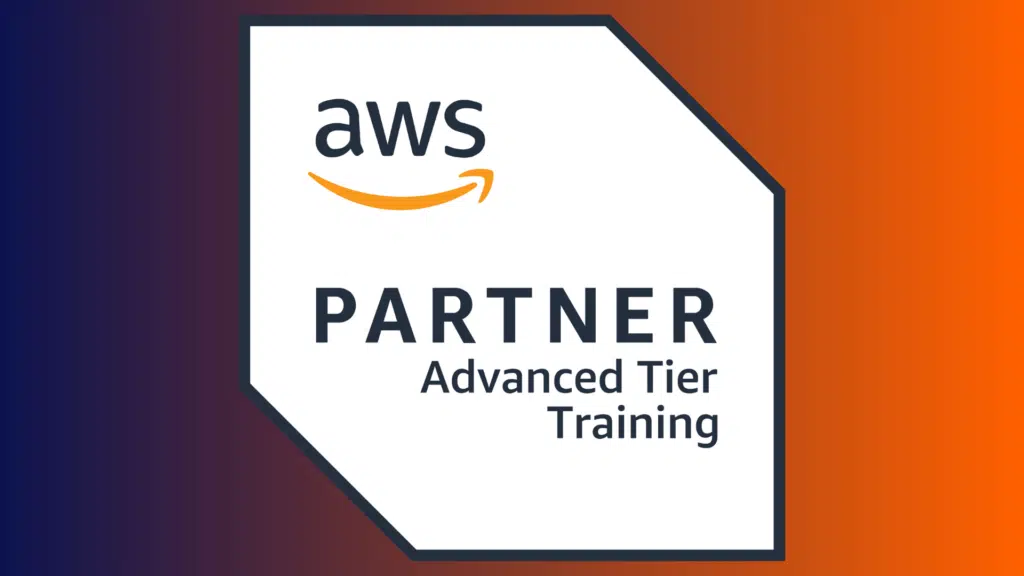
Objectives
- The working definition of AWS
- Differences between on-premise, hybrid cloud & all-cloud systems.
- Describe the AWS Cloud’s fundamental global infrastructure.
- Six advantages of the AWS Cloud.
- Understand AWS services such as Compute, Network, Databases & Storage
- Explain the AWS Well-Architected Framework.
- Describe the shared responsibility paradigm | AWS Cloud’s primary security services.
- Migration to the AWS Cloud.
- Financial advantages of the AWS Cloud for cost control in a business.
- Fundamental Payment | Account management and pricing structures.
- Preparing for the AWS Certified Cloud Practitioner Exam (CLF-C01)
Prerequisites
- General IT knowledge of how Computers work
Intendend Audience
- Freshers looking to prepare for the AWS Certified Cloud Practitioner Exam
- Business Analysts | Legal personel
- Marketing | Project Managers
- Sales | Other IT professionals
Module Breakdown
Module 1: Introduction to Amazon Web Services
- Summarize the benefits of AWS
- Describe differences between on-demand delivery and cloud deployments
- Summarize the pay-as-you-go pricing model
Module 2: Compute in the Cloud
- Describe the benefits of Amazon Elastic Compute Cloud (Amazon EC2) at a basic level
- Identify the different Amazon EC2 instance types
- Differentiate between the various billing options for Amazon EC2
- Describe the benefits of Amazon EC2 Auto Scaling
- Summarize the benefits of Elastic Load Balancing
- Give an example of the uses for Elastic Load Balancing
- Summarize the differences between Amazon Simple Notification Service (Amazon SNS) and Amazon Simple Queue Services (Amazon SQS)
- Summarize additional AWS compute options
Module 3: Global Infrastructure and Reliability
- Summarize the benefits of the AWS Global Infrastructure
- Describe the basic concept of Availability Zones
- Describe the benefits of Amazon CloudFront and Edge locations
- Compare different methods for provisioning AWS services
Module 4: Networking
- Describe the basic concepts of networking
- Describe the difference between public and private networking resources
- Explain a virtual private gateway using a real life scenario
- Explain a virtual private network (VPN) using a real life scenario
- Describe the benefit of AWS Direct Connect
- Describe the benefit of hybrid deployments
- Describe the layers of security used in an IT strategy
- Describe which services are used to interact with the AWS global network
Module 5: Storage and Databases
- Summarize the basic concept of storage and databases
- Describe benefits of Amazon Elastic Block Store (Amazon EBS)
- Describe benefits of Amazon Simple Storage Service (Amazon S3)
- Describe the benefits of Amazon Elastic File System (Amazon EFS)
- Summarize various storage solutions
- Describe the benefits of Amazon Relational Database Service (Amazon RDS)
- Describe the benefits of Amazon DynamoDB
- Summarize various database services
Module 6: Security
- Explain the benefits of the shared responsibility model
- Describe multi-factor authentication (MFA)
- Differentiate between the AWS Identity and Access Management (IAM) security levels
- Describe security policies at a basic level
- Explain the benefits of AWS Organizations
- Summarize the benefits of compliance with AWS
- Explain primary AWS security services at a basic level
Module 7: Monitoring and Analytics
- Summarize approaches to monitoring your AWS environment
- Describe the benefits of Amazon CloudWatch
- Describe the benefits of AWS CloudTrail
- Describe the benefits of AWS Trusted Adviso
Module 8: Pricing and Support
- Understand AWS pricing and support models
- Describe the AWS Free Tier
- Describe key benefits of AWS Organizations and consolidated billing
- Explain the benefits of AWS Budgets
- Explain the benefits of AWS Cost Explorer
- Explain the primary benefits of the AWS Pricing Calculator
- Distinguish between the various AWS Support Plans
- Describe the benefits of AWS Marketplace
Module 9: Migration and Innovation
- Understand migration and innovation in the AWS Cloud
- Summarize the AWS Cloud Adoption Framework (AWS CAF)
- Summarize six key factors of a cloud migration strategy
- Describe the benefits of various AWS data migration solutions, such as AWS Snowcone, AWS Snowball, and AWS Snowmobile
- Summarize the broad scope of innovative solutions that AWS offers
- Summarize the five pillars of the AWS Well-Architected Framework
Module 10: AWS Certified Cloud Practitioner Basics
- Determine resources for preparing for the AWS Certified Cloud Practitioner examination
- Describe benefits of becoming AWS Certified
Talk to a Learning Advisor
Tablet View
Popular AWS Courses
FAQs
To enroll in this course, choose the starting date and make an online payment. Once your payment is confirmed, our team will reach out to you.
You may reach out at the contact number listed on our official website or write us at info@cloudwizardconsulting.com
Wire Transfer, Credit Card, Debit Card, UPI & Purchase Order.
There is no minimum number of candidates required, we are happy to train 1 to 1 . With regards to the maximum number, we can accomodate 30 learners in one batch.
- Training Delivered by an Amazon Authorized Instructor.
- AWS Content E-Kit
- Hands-on-labs for 30 days
- Class attendance certificate
You will get the access to course content & lab on first day of your training session.
The course Completion Certificate will be issued to your email id within 2 weeks of completing your course.
A one-day course could be delivered over two half day sessions (4 hours a day), or a three-day course could be delivered over five days (4 hours a day)
AWS Cloud Practitioner Essentials
This course is designed for individuals with little to no experience on the AWS Cloud. The learners will learn about AWS Cloud concepts, AWS services such as Security, AWS Architecture, Pricing and Support to develop their knowledge on the AWS Cloud.
AWS Services such as Compute, Networking, Database and Storage along with AWS Well-Architected Framework, AWS Cloud Migration and the shared responsibility model are covered in detail. The course also helps in preparation for the AWS Certified Cloud Practitioner Exam
The course can be taken up Sales, Legal, Marketing, Business Analysts, Project Managers, IT professionals and anyone in general looking to start up within the AWS Cloud domain.The course is delivered by an Amazon Authorised Instructor with a mix of presentations, class activities and frequent knowledge checks.
1 Day / 8 Hours
Live Class
Certificate on completion
Objectives
- The working definition of AWS
- Differences between on-premise, hybrid cloud & all-cloud systems.
- Describe the AWS Cloud’s fundamental global infrastructure.
- Six advantages of the AWS Cloud.
- Understand AWS services such as Compute, Network, Databases & Storage
- Explain the AWS Well-Architected Framework.
- Describe the shared responsibility paradigm | AWS Cloud’s primary security services.
- Migration to the AWS Cloud.
- Financial advantages of the AWS Cloud for cost control in a business.
- Fundamental Payment | Account management and pricing structures.
- Preparing for the AWS Certified Cloud Practitioner Exam (CLF-C01)
Prerequisites
- General IT knowledge of how Computers work
Intended Audience
- Freshers looking to prepare for the AWS Certified Cloud Practitioner Exam
- Business Analysts | Legal personel
- Marketing | Project Managers
- Sales | Other IT professionals
Module 1: Introduction to Amazon Web Services
- Summarize the benefits of AWS
- Describe differences between on-demand delivery and cloud deployments
- Summarize the pay-as-you-go pricing model
Module 2: Compute in the Cloud
- Describe the benefits of Amazon Elastic Compute Cloud (Amazon EC2) at a basic level
- Identify the different Amazon EC2 instance types
- Differentiate between the various billing options for Amazon EC2
- Describe the benefits of Amazon EC2 Auto Scaling
- Summarize the benefits of Elastic Load Balancing
- Give an example of the uses for Elastic Load Balancing
- Summarize the differences between Amazon Simple Notification Service (Amazon SNS) and Amazon Simple Queue Services (Amazon SQS)
- Summarize additional AWS compute options
Module 3: Global Infrastructure and Reliability
- Summarize the benefits of the AWS Global Infrastructure
- Describe the basic concept of Availability Zones
- Describe the benefits of Amazon CloudFront and Edge locations
- Compare different methods for provisioning AWS services
Module 4: Networking
- Describe the basic concepts of networking
- Describe the difference between public and private networking resources
- Explain a virtual private gateway using a real life scenario
- Explain a virtual private network (VPN) using a real life scenario
- Describe the benefit of AWS Direct Connect
- Describe the benefit of hybrid deployments
- Describe the layers of security used in an IT strategy
- Describe which services are used to interact with the AWS global network
Module 5: Storage and Databases
- Summarize the basic concept of storage and databases
- Describe benefits of Amazon Elastic Block Store (Amazon EBS)
- Describe benefits of Amazon Simple Storage Service (Amazon S3)
- Describe the benefits of Amazon Elastic File System (Amazon EFS)
- Summarize various storage solutions
- Describe the benefits of Amazon Relational Database Service (Amazon RDS)
- Describe the benefits of Amazon DynamoDB
- Summarize various database services
Module 6: Security
- Explain the benefits of the shared responsibility model
- Describe multi-factor authentication (MFA)
- Differentiate between the AWS Identity and Access Management (IAM) security levels
- Describe security policies at a basic level
- Explain the benefits of AWS Organizations
- Summarize the benefits of compliance with AWS
- Explain primary AWS security services at a basic level
Module 7: Monitoring and Analytics
- Summarize approaches to monitoring your AWS environment
- Describe the benefits of Amazon CloudWatch
- Describe the benefits of AWS CloudTrail
- Describe the benefits of AWS Trusted Adviso
Module 8: Pricing and Support
- Understand AWS pricing and support models
- Describe the AWS Free Tier
- Describe key benefits of AWS Organizations and consolidated billing
- Explain the benefits of AWS Budgets
- Explain the benefits of AWS Cost Explorer
- Explain the primary benefits of the AWS Pricing Calculator
- Distinguish between the various AWS Support Plans
- Describe the benefits of AWS Marketplace
Module 9: Migration and Innovation
- Understand migration and innovation in the AWS Cloud
- Summarize the AWS Cloud Adoption Framework (AWS CAF)
- Summarize six key factors of a cloud migration strategy
- Describe the benefits of various AWS data migration solutions, such as AWS Snowcone, AWS Snowball, and AWS Snowmobile
- Summarize the broad scope of innovative solutions that AWS offers
- Summarize the five pillars of the AWS Well-Architected Framework
Module 10: AWS Certified Cloud Practitioner Basics
- Determine resources for preparing for the AWS Certified Cloud Practitioner examination
- Describe benefits of becoming AWS Certified
Talk to a Learning Advisor
FAQs
Yes, we are an AWS Advanced Tier Training Partner
Anyone who wants to start a profession in AWS cloud is fit to enroll in this course. No prior knowledge of coding or other technical skills is required.
To enroll in this course, choose the starting date and make an online payment. Once your payment is confirmed, our team will reach out to you.
You may reach out at the contact number listed on our official website or write to us at info@cloudwizard.wpenginepowered.com.
Wire Transfer, Credit Card, Debit Card, UPI & Purchase Order
There is no minimum number of candidates required, we are happy to train 1 to 1 should you wish. With regard to the maximum number, we can accommodate 30 learners in one batch.
1. Training delivered by an Amazon Authorised Instructor
2. AWS Content E-Kit
3. Hands-on labs- 30 days
4. Class attendance certificate
You will get the access to course content & lab on first day of your training session.
The course completion certificate will be issued to your email id within 2 weeks of completing your course.
A one-day course could be delivered over two half day sessions (4 hours a day), or a three-day course could be delivered over five days (4 hours a day).


